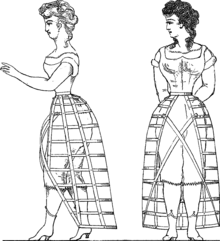crinolette
Appearance
English
[edit]
Etymology
[edit]Noun
[edit]crinolette (plural crinolettes)
- (historical) A whalebone, cane, or steel framework that was worn between petticoat and dress, attached at the waist and projecting backwards but not as far to the sides as in the case of a full hoop skirt.
- 1883 October 6, “Hurrah, For the Princess!”, in Punch, volumes 84-85, page 161:
- The Princess of Wales has won two millinery victories this year -- both on the side of common sense. She has banished the crinolette, in spite of Paris. She has retained the small bonnet in fashion, still in spite of Paris.
- 1935, Baron Angus Holden, Elegant modes in the nineteenth century: from high waist to bustle:
- The jupon or steel petticoat, which in the crinoline period was bell-shaped, in 1869 became flat in front and at the back sloped groundwards from the waist, where the tournure or "crinolette" projected over the jupon in a sweeping curve.
- 1995, Karen Baclawski, The Guide to Historic Costume, page 95:
- About 1873, the crinolette was abandoned and the bustle was forced to drop down the back of the skirt because of the long line of the popular cuirass bodice; it was later discarded when the fashionable silhouette narrowed still further with the 'princess line' dresses of the later 1870s.
